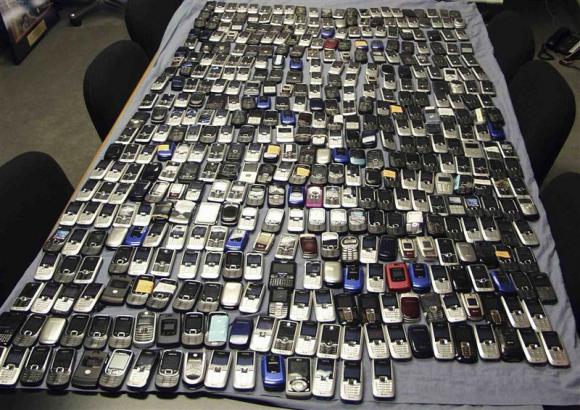Smuggled cellphone use a growing concern for U.S. prisons
Daily News Article — Posted on April 21, 2014

Mobile phones seized by Mississippi authorities at prisons across the state are seen in this undated handout picture provided by the Mississippi Department of Corrections. (Reuters/Mississippi Department of Corrections/Handout via Reuters)
(by Colleen Jenkins, Reuters) WINSTON-SALEM, North Carolina — Cellphones smuggled into prisons by corrupt guards, concealed in food containers or hurled over security fences are an increasing worry for law enforcement as prisoners use them to intimidate witnesses, direct drug deals and plan escapes.
The concerns about these contraband devices came into the national spotlight this month when U.S. officials accused a member of the notorious Bloods gang serving a life sentence in North Carolina of using a mobile phone hidden in his prison cell to arrange the kidnapping of the father of a woman who prosecuted him.
There are no widely available reliable figures on how many cellphones are in the hands of the 2.3 million inmates in local, state and federal prisons in the United States, but statistics point to a swift rise of the problem.
In California, for instance, the number of contraband cellphones discovered by corrections staff jumped to more than 15,000 in 2011, more than 10 times the 1,400 seized in 2007.
“Prison officials used to have to worry about cigarettes and drugs and other weapons. Now it’s cellphones,” said Tod Burke, a criminal justice professor at Radford University in Virginia. “Make no mistake about it, the cellphones are as dangerous or even more dangerous than the other contraband.”
States are taking a variety of steps to crack down on prison cellphone possession, starting with passing laws that make it a crime, said Burke, a former police officer.
In addition to using metal detectors, X-ray body scanners, pat downs and WiFi signal searches, many enlist police dogs trained to sniff out phones.
In March, Mississippi’s corrections department said it would spend $1.3 million to install high netting barriers at its prisons to keep items from being lobbed over fences.
Cellphones are sometimes hidden inside basketballs, footballs or tennis balls, even delivered by shooting an arrow over the wall, experts said.
Mississippi plans to expand use of technology that allows authorities to block unauthorized calls within a prison. The system has stopped nearly 6 million illegal cellphone calls and texts since its 2010 launch, according to the state.
“I lose a lot of sleep worrying about cellphones,” Mississippi Corrections Commissioner Christopher Epps, who serves as president of the American Correctional Association, said in a statement. “We have proof they have been used in escapes, to put hits out on people, and for other criminal activities.”
Maryland officials also said this year that they had purchased “managed access” technology for the city detention center in crime-plagued Baltimore as part of an intensified push against contraband cellphones.
A federal indictment in November said the proliferation of cellphones enabled leaders of the Black Guerilla Family prison gang to coordinate crimes such as drug trafficking, money laundering and murder from the Baltimore jail.
In North Carolina, law enforcement officials said prison inmate Kelvin “Dizzy” Melton used a mobile phone to give instructions on how to kill a prosecutor’s father and dispose of his body.
Kidnappers snatched Frank Janssen, 63, from his home in Wake Forest, North Carolina on April 5 and held him hostage in an Atlanta apartment until federal agents rescued him four days later. Eight people, including Melton, have been charged in the abduction. [Kelvin Melton, a member of the Bloods gang, was prosecuted by Wake County assistant district attorney Colleen Janssen, the daughter of Frank Janssen.]
Law enforcement officials would not comment on how Melton obtained the cellphone, but said he smashed it when authorities arrived to confiscate it. An investigation is ongoing, North Carolina prisons director George Solomon said. “This has been an ongoing battle for several years,” Solomon said. “It’s a major security problem for us.”
Reprinted here for educational purposes only. May not be reproduced on other websites without permission from Thomson Reuters. Visit the website at Reuters .com.
Questions
1. How are prisoners across the country obtaining cell phones in jail?
2. How much of an increase was there in the number of cell phones confiscated by officials in California since 2007?
3. For what purposes do prisoners use the phones?
4. What specific incident recently highlighted prison officials’ concerns over prisoners acquiring cell phones?
5. What tactics are officials using to address the problem?
